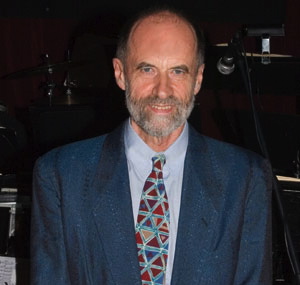 Gary Morgan (saxophonist, bassist, arranger, composer) was born in Santiago, Chile and moved to Toronto, Ontario, Canada, at the age of 2. Tuned to music from an early age, he digested the popular music of the day, country music, Top 40, blues, big bands, rock & roll and rhythm & blues. Formative events in his early life included hearing the bands of Lionel Hampton, Count Basie and Illinois Jaquet up close, “these guys were really having fun!”, and hearing Salsa for the first time, booming from a record shop in the Times Square subway station, on a Christmas visit to New York with his parents.
Gary Morgan (saxophonist, bassist, arranger, composer) was born in Santiago, Chile and moved to Toronto, Ontario, Canada, at the age of 2. Tuned to music from an early age, he digested the popular music of the day, country music, Top 40, blues, big bands, rock & roll and rhythm & blues. Formative events in his early life included hearing the bands of Lionel Hampton, Count Basie and Illinois Jaquet up close, “these guys were really having fun!”, and hearing Salsa for the first time, booming from a record shop in the Times Square subway station, on a Christmas visit to New York with his parents.
Another memorable experience from his early teens was attending the fabled Jazz at Massey Hall concert of Charlie Parker, Dizzy Gillespie et al. Memorable because he couldn’t stand the music — “too many notes” for his tender ears, and he lost his part time grocery job for deserting his fellow workers.
He started instrumental music in high school, wanted the drums, but was persuaded to take up the saxophone instead by his teacher. After a mediocre academic career, he settled down to practicing and freelanced in Toronto for 15 years, playing saxophone and woodwinds on TV variety shows, recordings, movie soundtracks, jingles and musical theater.
During this period Gary appeared with various musical artists including Tony Bennett, Ella Fitzgerald, Nancy Wilson, Dionne Warwick, Otis Redding, Gladys Knight, (Little) Stevie Wonder, Duke Ellington, Dizzy Gillespie, Woody Herman, Jose Feliciano, Quincy Jones, Lionel Hampton, Oscar Peterson, Ray Charles, Rob McConnell & The Boss Brass, Buddy Rich, Benny Goodman and Henry Mancini.
Gary also studied theory, harmony and composition privately, as well as electronic music. He began composing and arranging music for various ensembles he was performing with, and leading his own small jazz groups. Signature memories from that era included his first trips to Cuba and Brazil. Brazil, in particular, has been a dominant influence on Gary’s music: